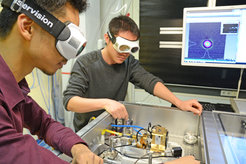A Keen Sense for Molecules
Laser physicists from the Laboratory of Attosecond Physics at the LMU and the MPQ have developed an extremely powerful broadband infrared light source. This light source opens up a whole new range of opportunities in medicine, life science, and material analysis.
Infrared light has a keen sense for molecules. With the help of this light, researchers are able to go in search of the small particles which shape and determine our lives. The phenomenon, in which infrared light sets molecules in vibration, is pivotal in this search. Scientists are exploiting this phenomenon by using infrared light to analyze the molecular makeup of samples. In the hope that this analysis can become even more exact, the laser physicists from the Laboratory of Attosecond Physics (LAP) at the Ludwig-Maximilians-Universität (LMU) in Munich and the Max Planck Institute of Quantum Optics (MPQ) have developed an infrared light source that has an enormously broad spectrum of wavelengths. This light source is the first of its kind worldwide and can be used to help detect the smallest amounts of molecules in liquids like blood.

When infrared light encounters molecules, they begin to vibrate. In this process, each particular type of molecule is brought into motion by a very specific set of different wavelengths in the range from 3 to 20 micrometers.
By examining the wavelengths of the light being emitted after this excitation, researchers are able to derive the molecular composition of the sample. The more powerful the source of infrared light and the more wavelengths utilized, the higher the chance of determining the sample composition, in for example breath or blood.
The LAP physicists have set themselves this challenge. They developed a new disc laser capable of emitting very short pulses at 77,000 pulses per second, amounting to 19 W of average power. The pulses themselves are mere femtoseconds long (a femtosecond is one-millionth of one billionth of a second). Based on this laser, researchers generated a wavelength spectrum spanning from 4.5 to 20 micrometers (in comparison a person is able to see light in a range between 0.35 and 0.7 micrometers).
With this system, researchers have achieved the broadest simultaneous infrared coverage from a solid state laser. Moreover, the infrared laser pulses emitted should correspond to a sub-cycle pulse in the time domain.
This new light source opens up countless opportunities for the physicists of better understanding the fundamental properties of solid and soft matter. The analysis of light spectrums after interactions with material with infrared spectroscopy and microscopy allows the more precise and accurate conceptualization of research methods.
The LAP team utilizes these methods for driving the so-called “Broadband Infrared Diagnostics” project. In the framework of this project, the scientists are interested in assessing the molecular makeup of blood and breath. Should particular molecules be present, like the kind that appear in cancer patients, this could prove to be a reliable indicator that further examination is needed. A new diagnostic tool for the early detection of diseases might just have been developed. Thorsten Naeser












